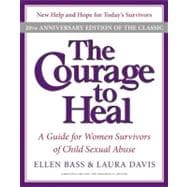Come to terms with your past while moving powerfully into the future
The Courage to Heal is an inspiring, comprehensive guide that offers hope and a map of the healing journey to every woman who was sexually abused as a child—and to those who care about her. Although the effects of child sexual abuse are long-term and severe, healing is possible.
Weaving together personal experience with professional knowledge, the authors provide clear explanations, practical suggestions, and support throughout the healing process. Readers will feel recognized and encouraged by hundreds of moving first-person stories drawn from interviews and the authors' extensive work with survivors, both nationally and internationally.
This completely revised and updated 20th anniversary edition continues to provide the compassionate wisdom the book has been famous for, as well as many new features:
-Contemporary research on trauma and the brain
-An overview of powerful new healing tools such as imagery, meditation, and body-centered practices
-Additional stories that reflect an even greater diversity of survivor experiences
-The reassuring accounts of survivors who have been healing for more than twenty years
-The most comprehensive, up-to-date resource guide in the field
-Insights from the authors' decades of experience
Cherished by survivors, and recommended by therapists and institutions everywhere, The Courage to Heal has often been called the bible of healing from child sexual abuse. This new edition will continue to serve as the healing beacon it has always been.








